

| The distribution of Volucella Hoverflies in Nottinghamshire | ||
| The Genus Volucella, is
represented by some of our largest and most spectacular
Hoverflies and unusually for Hoverflies and Diptera in
general, they are all fairly easy to identify to species
level, either in the flesh or via good photographs. Two are excellent Hornet mimics and there is one Bumblebee mimic, which often means the public are fooled into thinking these impressive insects aren't actually flies at all . All are associated with Bee and Wasp nests, either scavenging from the bottom of the nest or (in the case of Volucella inanis) as ectoparasites of Wasp larvae. Nectar sources for Volucella Hoverflies All our Volucellas occur as adults from mid-Summer to early Autumn, visiting flowers such as Bramble, Devil's-bit Scabious (Succisa pratensis) and a range of Umbellifers. Fennel (Foeniculum vulgare) is particularly attractive. In gardens, they are strongly attracted to the flowers of Buddleia, but the hardy perennial Astrantia (shown in the accompanying photographs of Volucella zonaria and inanis) will certainly also attract V. pellucens. |
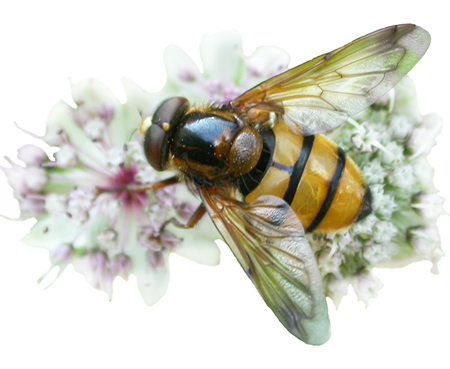 |
|
| .... | ||
Nottinghamshire distribution of Volucella zonaria, inanis, pellucens and bombylans Volucella zonaria has the most restricted range in Nottinghamshire of the four species. Based solely on the records we have, or which have been sent in to us, V. zonaria is uncommon within suburban Nottingham, but considerably rarer in rural areas. V. inanis has moved north through the UK in recent decades and the number of Nottinghamshire records has also increased. Up to four V. inanis were recorded by Pauline Bradford, from the Nottinghamshire Wildlife Trust's Dyscarr Wood in the north-west of the county during 2014. |
||
| .... |
 |
| .... | ||
| Pauline recorded many Hoverflies at Dyscarr Wood during the course of 2014 and kindly provided us with her records for inclusion into the Nottinghamshire distribution maps. Her meticulous recording, also provided us with the chance to use her data to show the numbers of Volucella pellucens at Dyscarr, over the Summer months. V. pellucens is the commonest of the Volucellas across Nottinghamshire, and the above graph shows a peak count of 88 on June 20th. Volucella bombylans is another common Hoverfly, found more widely than the number of records on the distribution map might suggest. | ||
| .... | ||
| Species accounts | ||
| Volucella zonaria (Poda, 1761) | Volucella inanis (Linnaeus, 1758) | |
| Description:
A very large Hoverfly, Volucella zonaria
is one of two Hornet mimics, but much larger than the
equally impressive V. inanis. The chestnut
colouration is distinctive enough to seperate it from V.
inanis, although both share the strong yellow
suffusion to the wings. Nottinghamshire distribution: Apart from a single record at Dyscarr Wood in the north-west of Nottinghamshire, most records are from the suburban areas of Nottingham, where it is attracted to garden flowers. We have seen V. zonaria in company with V. inanis. |
Description:
Another large and spectacular Hornet mimic. It
is still described as being local, and has appeared in
several counties (including Nottinghamshire) since the
late 1990's. Nottinghamshire distribution: From the records we have, V. inanis has a similar Nottinghamshire distribution to V. zonaria and the two can occasionally be found in suburban gardens together. All records are from sites west of the River Trent, but this may well be due to observer coverage than a westerly distribution. |
|
| .... | ||
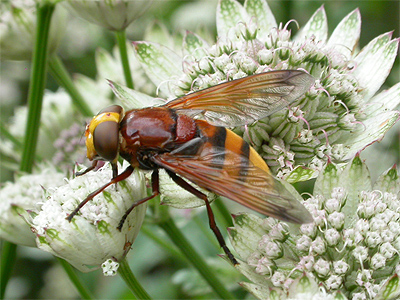 |
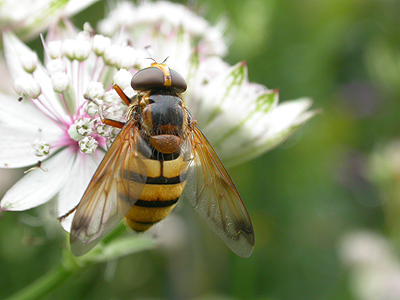 |
|
| .... | ||
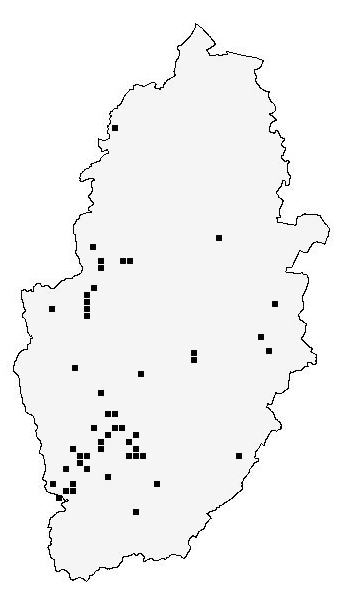 |
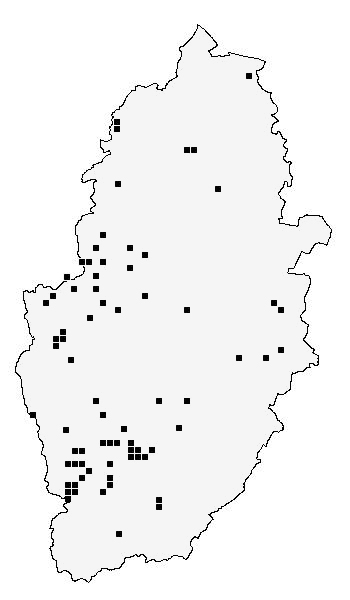 |
|
| The records for the Nottinghamshire distribution map are currently provided by the following contributors - Richard Rogers. Trevor and Dilys Pendleton. Tim Sexton. Lawrence Archibald. J. Ziskind. Jerry Clough. Craig Howat. Adrian Dutton. Pauline Bradford. Wil Heeney. Rob Johnson. Nottinghamshire Wildlife Trust. Darren Matthews. Michael Blount. Mike Hill. Robert and Jill Carlyle. Peter Acton. Linda Adams. Tom Hibbert. Simon Barsby. Michael Craven. Chloe Ryder. NBGRC. Meg Skinner. Barry Lygo. Tom Shields. David Shaw. Nigel Beasley. | The records for the Nottinghamshire distribution map are currently provided by the following contributors - Richard Rogers. Trevor and Dilys Pendleton. Sean Tobin. Netherfield Wildlife Group. Adrian Dutton. Pauline Bradford. Tim Sexton. Derek Cox. Nottinghamshire Wildlife Trust. Darren Matthews. Wil Heeney. Antoni Lachetta. Wil Heeney. Carl Cornish. Peter Acton. Damian Taylor. Tom Shields. David Shaw. Phil Lee. | |
| Volucella pellucens (Linnaeus, 1758) | Volucella bombylans (Linnaeus, 1758) | |
| Description:
V. pellucens is one of our most
distinctive Hoverflies, being a large species (like all Volucellas)
with a distinctive white band across the abdomen. Nottinghamshire distribution: More widely distributed and found in a wide range of habitats, across the whole of Nottinghamshire than the other three species, V. pellucens can be expected wherever there are flowers. Creeping Thistle seems to be particularly attractive to them as a nectar source. Does turn up regularly in suburban gardens . |
Description:
This is the only Bumblebee mimic of the UK's Volucella
Hoverflies. There are two colour forms, with the
commonest shown below, plus an all black form with with
orange/red at the end of the abdomen. The antennae are
distinctly plumose (feathered). Nottinghamshire distribution: Found along woodland rides, the edges of woodland and grassy habitats etc, occurring fairly commonly across most of Nottinghamshire. |
|
| .... | ||
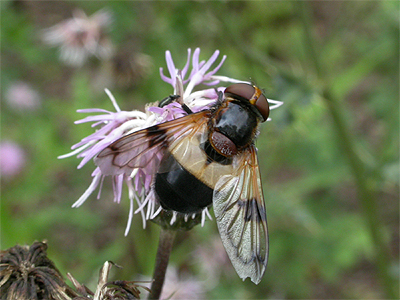 |
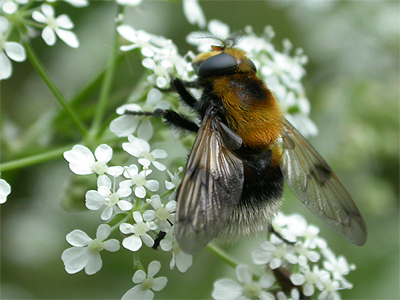 |
|
| .... | ||
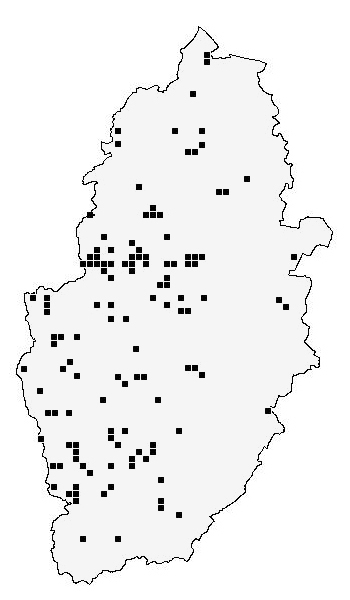 |
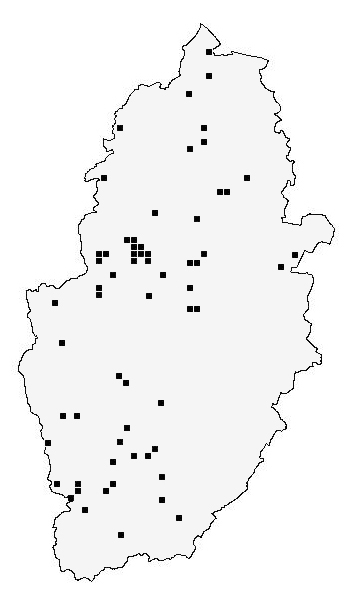 |
|
| The records for the Nottinghamshire distribution map are currently provided by the following contributors - Richard Rogers. Trevor and Dilys Pendleton. Brian Wetton. Wil Heeney. Netherfield Wildlife Group. Pauline Bradford. Nottinghamshire Wildlife Trust. Tim Sexton. Nottingham City Council. Darren Matthews. Sherwood Forest Invertebrate Directory 2014. Derek Whiteley. Stuart Warrington. The National Trust (Clumber Park invertebrate records). Allan and Annette Binding (Clumber Park invertebrate records). Michael Craven. NBGRC. Meg Skinner. David Shaw. | The records for the Nottinghamshire distribution map are currently provided by the following contributors - Richard Rogers. Trevor and Dilys Pendleton. Netherfield Wildlife Group. Pauline Bradford. Wil Heeney. Nottinghamshire Wildlife Trust. Tim Sexton. Nottingham City Council. Brian Wetton. Trevor and Dilys Pendleton (Sherwood Forest Invertebrate Directory 2014). Paul and Helen Brock. John and Denise Bingham. Josh Hedley. Darren Matthews. | |